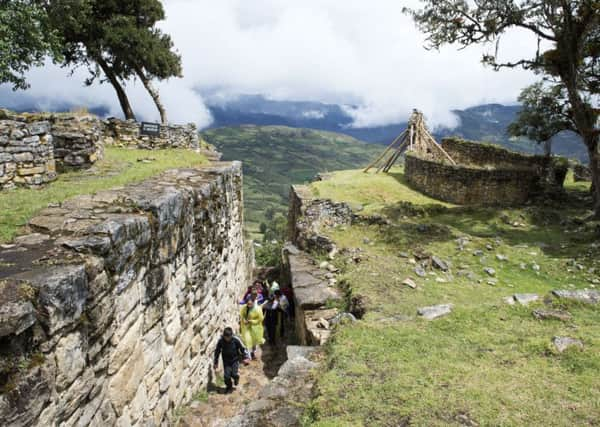Travel review: The ancient cloud forest citadel of Kuelap


Peru’s ancient civilisations had a habit of building sky-high, altitude-busting citadels. Machu Picchu is the most famous of all, but further north in the cloud forests of Amazonas is a place far grander in age and scale. Yet few travellers even know it’s there.
Built in AD 500 by the Chachapoyas people, the fortress town of Kuelap predates Peru’s Inca big hitter by 900 years.
Advertisement
Hide AdAdvertisement
Hide AdSixteenth century chronicles written by Spanish conquistadors speak of Amazonas – a region of tumbling rivers, steep gorges and mountains quilted with frog green forests – as being one of the hardest regions to reach.
It remained that way up until recently when the opening of an airport at Jaen, in the neighbouring Cajamarca region, greatly eased access.
A big fuss is also being made about the new $24m cable car connecting Kuelap to the small village of Nuevo Tingo, turning a one and a half hour stomach-spinning drive around hairpin bends into an easy 20-minute glide.
Only a third of the site, eventually infiltrated by Incas in the late 1400s, has been excavated since being rediscovered in 1843. Efforts are under way to reverse some crude reconstructions in a bid to earn Unesco World Heritage status, and when I visit, workmen are hurriedly banging nails into walkways. Tourist numbers are expected to rise from 40,000 per year to 120,000, compared with the million-plus visitors Machu Picchu receives.
Advertisement
Hide AdAdvertisement
Hide AdAll over Amazonas, ancient sites paint a picture of Chachapoyas’ life and – even more fascinating – death. Hewn into vertical cliff faces, sarcophagi (stone coffins) in the shape of giant heads are topped with the prized skulls of warlords conquered by the warriors within.
There are more than 30 burial sites and I choose to visit the mausoleums at Revash (a two-hour drive south of Kuelap, followed by a short trek), where small triangular-roofed houses embedded in the rocks feature ruby red paintings of pumas and the Southern Cross.
More than 200 Inca and Chachapoya mummies are safeguarded in a controlled chamber at the excellent Leymebamba museum, a 75-minute drive from Revash. Small muslin bundles bound up with rope and daubed with circular faces sit on dusty shelves like cocooned, incubating pupae, although none will flourish with life again.
Still relatively new to tourism, Amazonas has few high-end accommodation options. I choose to stay at the idyllic Gocta Natura Cabins, an hour’s drive north from Chachapoyas, tracing the route of the Utcubamba River.
Advertisement
Hide AdAdvertisement
Hide AdLeaving a job at the World Bank in Lima behind her, conservationist Rocio Florez has opened an eco-lodge of five standalone cabins set within reforested terraces, attracting endemic birds to the area for the first time in decades. But even at full gusto, their joyous melodies are drowned by the roaring Gocta Falls, a gaze-grabbing sight from wherever you stand on the property.
Until 2005, when German Stefan Ziemendorff measured the two-drop cataract as one of the world’s highest (at 2,310ft), the residents of Coachimba village were terrified of the myth-laden site supposedly filled with irresistible gold treasures.
“Many people are still convinced they’ll get sick if they touch certain rocks in the forest,” Rocio tells me, which perhaps explains why so many ancient sites have been hidden for so long.
I wonder what mind-altering substances those ancestors must have been smoking, but find no magic plants on my sweaty, undulating 5km trail to the falls. Overcoming their fears, local villagers have made a good business in guiding tourists, perhaps finally finding their pot of gold.
Advertisement
Hide AdAdvertisement
Hide AdSun hits the gushing cataract at noon, although a fierce, shuddering wind blows permanently at its base. Pumpkin orange Andean cock-of-the-rock birds flit through the treetops as I head home to fresh mango juice and warm homemade bread sweetened with honey, enjoyed in the company of iridescent hummingbirds.
Rocio’s son, a respected chef in Lima, has trained some of the villagers to cook, and as a result, Gocta Natura Cabins serves easily the best food in a region rich in produce but poor in culinary invention.
Along with archaeology, environment is one of the key pillars for future tourism in Amazonas and almost half of Peru’s Private Conservation Areas can be found in the region, testimony to the love and respect local people have developed for their surroundings.
Biologist Perico Heredia is an advocate of the system, which allows individuals to request government recognition of their land as an important ecosystem.
Advertisement
Hide AdAdvertisement
Hide AdGrinning boyishly beneath a tatty baseball cap, the 50-something leads me through a tangled trail of rare orchids, ancient Inca stones and newly-recognised cedar trees, while excitedly regaling sightings of “small cats” caught on his camera traps. He’s currently extending the guest house at his Milpuj property, where he lives with his mother, a few kilometers from Kuelap.
Like everywhere in Amazonas, there’s a sense so much is waiting to be discovered.
No cable car is needed to access these areas; enthusiasm, diligence and reverence for nature will no doubt lead to more pots of gold.
GETTING THERE
Sarah Marshall was a guest of the Ultimate Travel Company (020 3051 8098, theultimatetravelcompany.co.uk) which tailors a 10-day Northern Peru experience from £2,950 per person, visiting Lima, Gocta Falls, Chiclayo and Trujillo. Most meals are included, as well as international and domestic flights, private guided sightseeing and private transfers throughout.